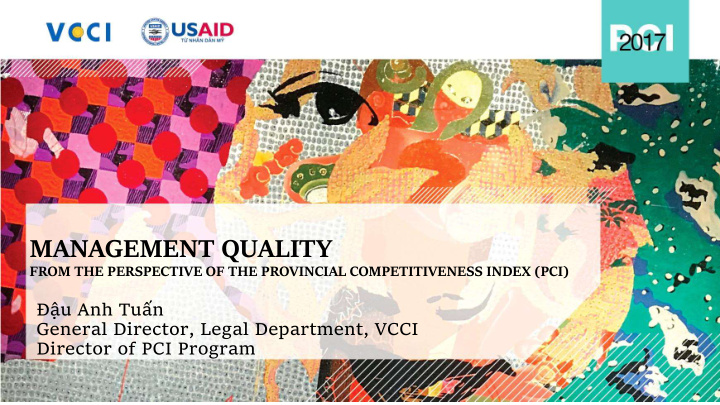



MANAGEMENT QUALITY FROM THE PERSPECTIVE OF THE PROVINCIAL COMPETITIVENESS INDEX (PCI) Đậu Anh Tuấn General Director, Legal Department, VCCI Director of PCI Program
Agenda 1. Overview of PCI 2. 2017 PCI Main Findings & Foreign Invested Enterprises (FIEs) views of Vietnam’s Business Environment 3. Management Quality through PCI survey results
1 Overview of PCI
Overview of PCI • What does the PCI measure? Actual provincial economic governance quality through best governance practices already found in localities. 10 PCI Subindices 1. Entry Costs 6. Policy Bias 2. Land Access 7. Proactive Leadership 3. Transparency 8. Business Support Services 4. Time Costs 9. Labor Training 5. Informal Charges 10. Law & Order
Size of the 2017 PCI survey 10.295 Domestic private enterprises 2.003 Newly registered enterprises A random sample stratified by province/city: • Legal form • Business sector • Firm age
13 Years of PCI 2005-2017 105.000 Domestic private firms 1 out of every 5 firms in operation has 12.263 responded to the PCI survey Foreign invested enterprises Số doanh nghiệp phản hồi qua các năm Number of Respondents over Time 15000 10295 12295 10158 10037 9981 9847 8169 8093 10000 7820 7300 7087 6700 6319 5000 1957 1952 1765 1609 1540 1533 1584 1550 1165 0 2005 2006 2007 2008 2009 2010 2011 2012 2013 2014 2015 2016 2017 Doanh nghiệp dân doanh Doanh nghiệp FDI Domestic Private Firms Foreign Invested Enterprises 10295
2 2017 PCI Main Findings & Foreign Invested Enterprises (FIEs) views of Vietnam’s Business Environment
2017 PCI Map
PCI and Core PCI over Time
Improvement in Core Index between 2006 and 2007
The 2017 Quality of Infrastructure Index and Improvements over Time
The wealthiest and fastest growing locations are those that excel in both governance and infrastructure
Foreign Invested Enterprises (FIEs) views of Vietnam’s Business Environment
THE 2017 PCI-FDI 1765 FIEs respondents, from 46 countries and territories
Legal Form Registration as domestic company under Enterprise Law on the rise
A positive trend toward higher-value- added products among FIEs!
FIEs are mainly export-oriented Question A14: Who are your customers?
FIEs’ inputs are largely imported, but significantly declined in 2017 Question A16: Who are your suppliers of intermediate goods and services?
The time needed to complete entry procedures is on the decline
Burden of post-entry regulations in decline
Informal charges on a downward trend
Difficulty in recruiting skilled employees
Only 31% FIEs are satisfied with labor quality Scores of vocational training quality have not improved much over time
Labor relations have improved
Business confidence is growing! Percentage of firms planning to increase the size of operations over the next 2 years (%) Private domestic firms Foreign invested enterprises Business Thermometer
3 Management Quality through PCI survey results
The Shrinking Vietnamese Private Firm
Growing Role of Private Sector in Economy
The Puzzle of the Shrinking Vietnamese Firm
Explanations for Declining Firm Size • Burdensome regulations • Poor quality infrastructure • Limited access to finance and land • Hidden barriers of lack of transparency and corruption • All play some role, but all focus on the limitations of the bureaucracy
Could differences between firms make a difference? • Is management quality a limitation to firm growth? • Influential research program of Nicholas Bloom (Stanford University) and co-authors has demonstrated in research around the world that better managers: • More productive • Exhibit greater growth • More likely to export • More likely to be connected to global supply chains
Measuring Management Quality
Measuring Management Quality: Performance Monitoring What describes what happened in the past year when a problem in the production/service delivery process arose? Examples: Finding a quality defect in a product or piece of machinery. Identifying a weakness in the capacity of employees delivering a service to customers.
Measuring Management Quality: Performance Monitoring In the past year, what best describes the use of data to support decision making at this establishment?
Measuring Management Quality: Target Setting In the past year, how many key performance indicators of were monitored at this establishment. Examples: Metrics on production, productivity, costs, waste, quality, inventory, energy usage, employee absenteeism, delivery of goods or services on time
Measuring Management Quality: Incentives In the past year, what was the primary way non-managers were promoted at this establishment?
Distribution of Average Management Quality
Who is a Good Manager?
Management Quality by Legal Form
Management Quality by Level of Education
Management Quality by Main Customer
Business Performance by Management Quality
A one point change in management quality leads to… Domestic Enterprises Foreign Enterprises
The PCI Diagnostic Puzzle Why are some governance reforms not appreciated/noticed by the business community? Could management quality make a difference?
Transparency Indicators by Management Quality
Results of Econometric Analysis • Re-calculated PCI at firm-level • Looked for correlation between firm’s management score and it’s assessment of provincial governance. • Accounted for firm employment, investment size, sector, gender and education of manager, and legal form. • Strong association between individual firm’s quality and the overall PCI score it. • Strongly associated with transparency, informal charges, proactivity, legal institutions. • Only weakly associated with entry costs and labor quality.
Management and Bribery: Domestic Firms
Management and Bribe Size
Good Managers Don’t See Bribery as a Social Norm
Final Thoughts • Major development challenge in Vietnam is the missing middle. • Governance reforms have made some progress, but more is needed. • Policy has not really explored the firm side of the story. • We find that good managers are more productive, more export oriented, and demonstrate faster investment and labor growth • They are better prepared to take advantage of local governance reforms. • Good managers are also less likely to bribe or see bribery as a social norm.
Conclusion
Clear Policy Implication We need to provide better training for the managers of Vietnam’s future.
www.pcivietnam.vn THANK YOU! www.pcivietnam.org
Recommend
More recommend